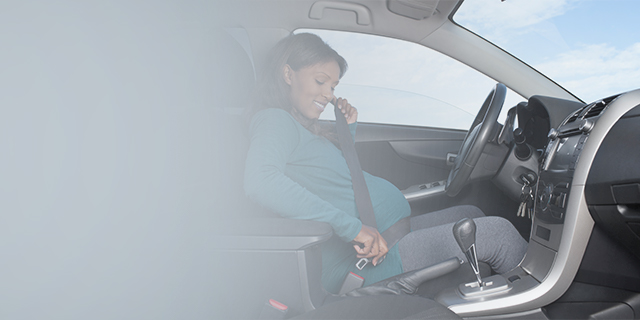Driving or riding in a car during pregnancy can be a bit awkward. Imagine having to deal with a tight parking situation at a late stage.
As your body changes proportions, it puts new demands on sitting comfort too. But the safety belt and airbag are of course, as crucial as ever.
Both buckled up
When driving, make sure to adjust the driver’s seat and steering wheel properly to give you full control of the car. You need to be within comfortable reach of the steering wheel and pedals, yet allowing as much space as possible between the steering wheel and the upper half of your body.
It is important that you always wear a safety belt – regardless of where in the car you sit. Equally important is the need to wear it correctly:
Remove bulky clothes to let the safety belt come as close to the body as possible;
Pull the lap belt over your thighs, lying flat under your belly;
Make sure the torso belt is positioned between your breasts and pulled tight.
5 Tips for Safe Driving
1. Use Your Senses – Look around: survey the road ahead so you know what’s coming up, and keep an eye on the road behind. Try planning your lane changes a few cars ahead, so that you have plenty of time to merge.
2. Stay Awake – If you are tired, do not drive. Driving is often monotonous, especially long distances or on the highway. If you feel yourself getting tired, pull over and take a short break to rest and regain alertness.
3. Drive According to the Conditions – If road conditions are hazardous, reduce your speed accordingly. Wet conditions can sometimes add around 18 metres to your braking distance at 100 km/h.
4. Only Use Your Phone when it is Safe – A driver’s first responsibility is the safe operation of the vehicle. The most important thing that you can do to prevent an accident is to avoid distraction. Pay attention to the road at all times. Wait until it is safe to make and receive phone calls and always ensure you use Bluetooth or hands-free. Otherwise find a safe place to stop and make your call.
5. Give Yourself Reaction Time – Use the three second rule to establish if you have allowed sufficient room between yourself and the car in front. Watch the car in front pass a certain point in the road and then count three seconds – if you get there before three, you’re driving too close.
Frequently Asked Questions
Q: Could the safety belt harm an unborn baby?
A: Research shows that the best protection for pregnant women and their unborn babies is for the mother to wear her three-point safety belt, and to wear it properly. This significantly reduces the foetal injury risk. Therefore, pregnant women should definitely use a safety belt at all times.
Q: How should I wear the safety belt while pregnant?
A: The top of the diagonal belt should be tight against the front of the shoulder, crossing down between the breasts and then down the side of the tummy. The lap section of the belt should be flat against the thighs and below the tummy, as low as possible – it should never be allowed to ride up in front of the tummy. The belt must fit as snugly as possible against the body. Check that there are no twists in the belt.
























